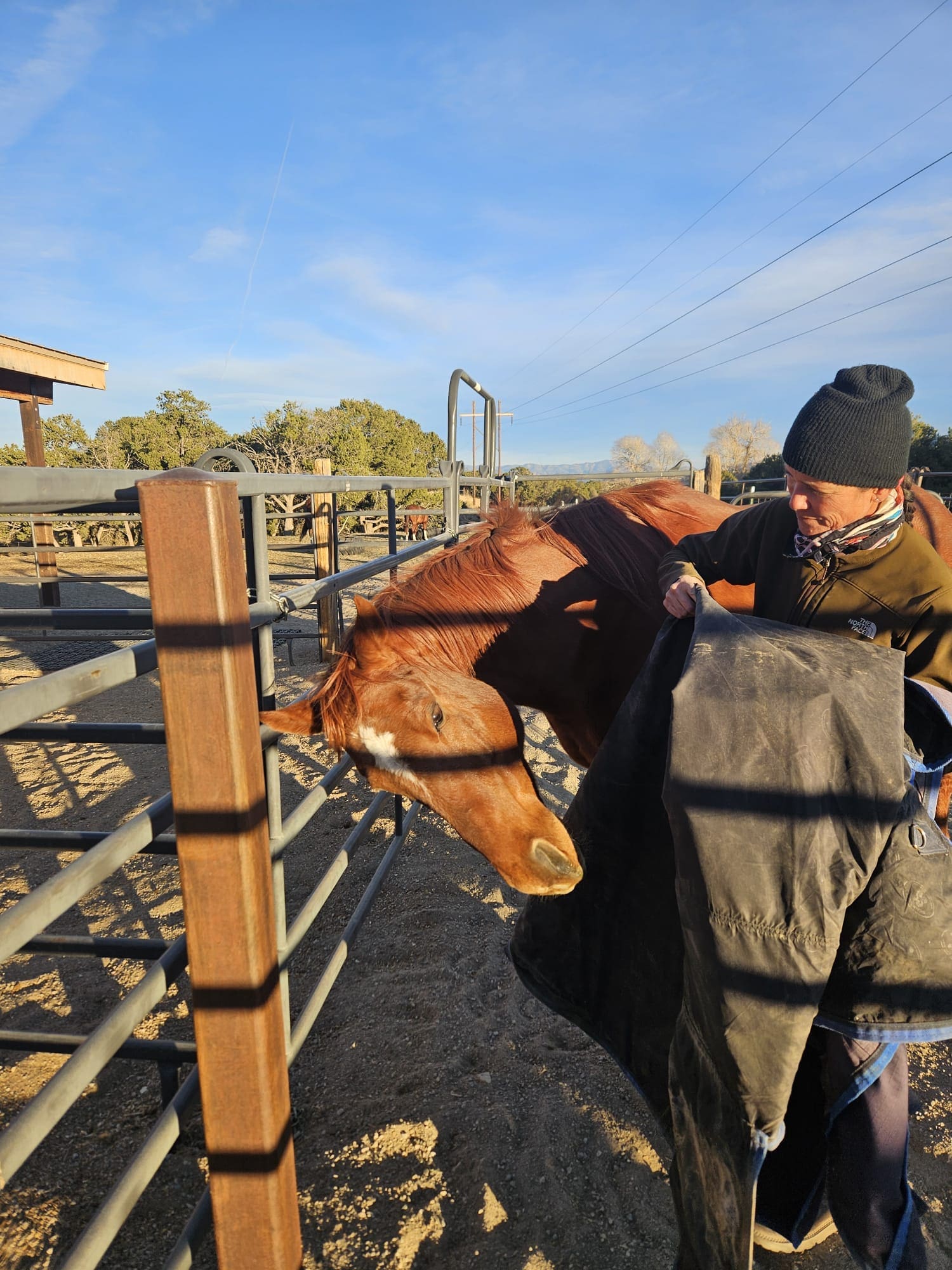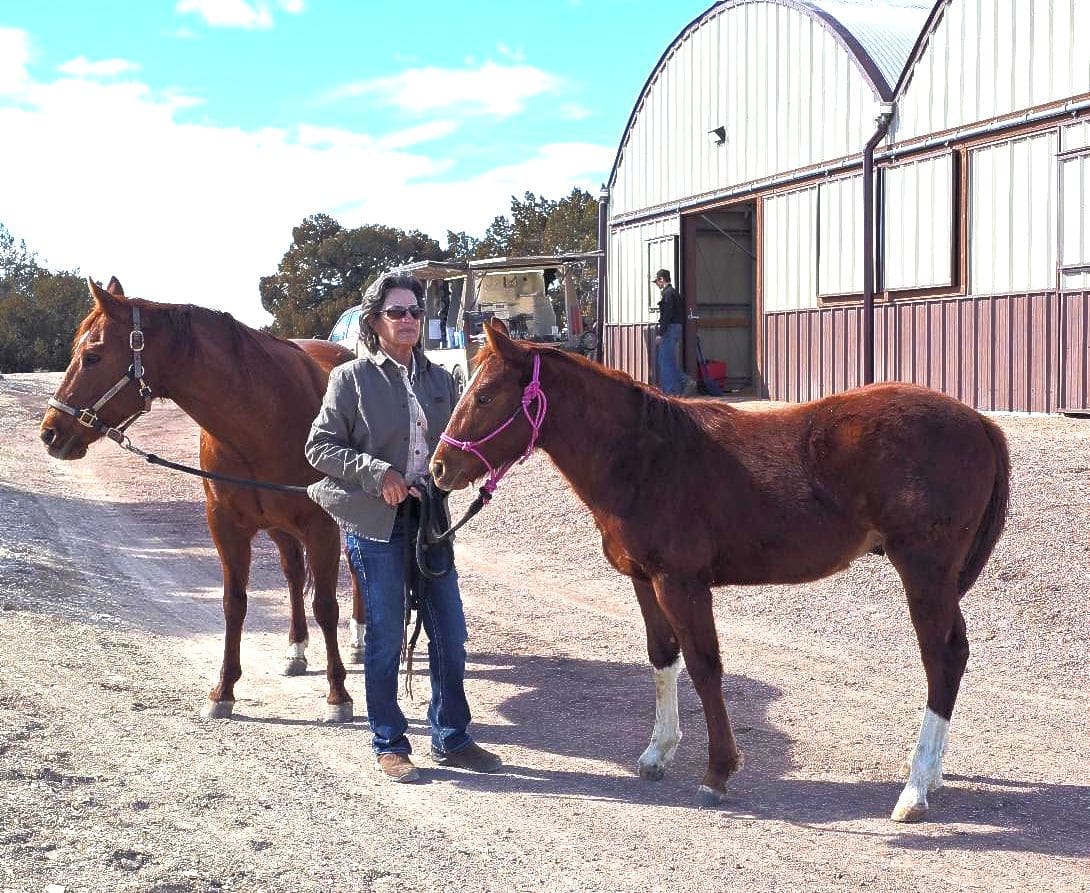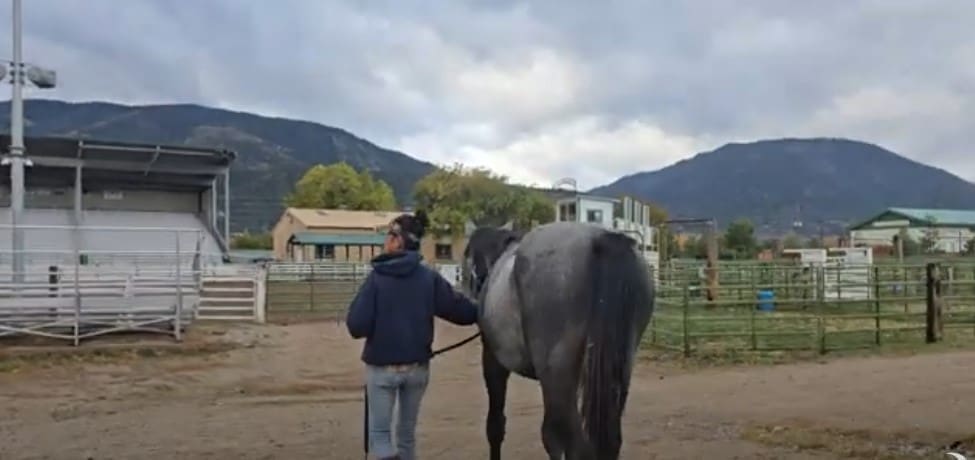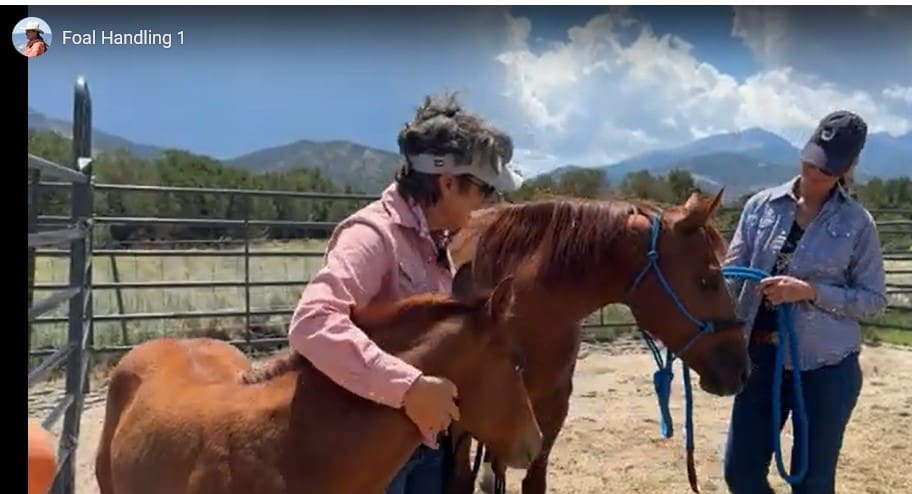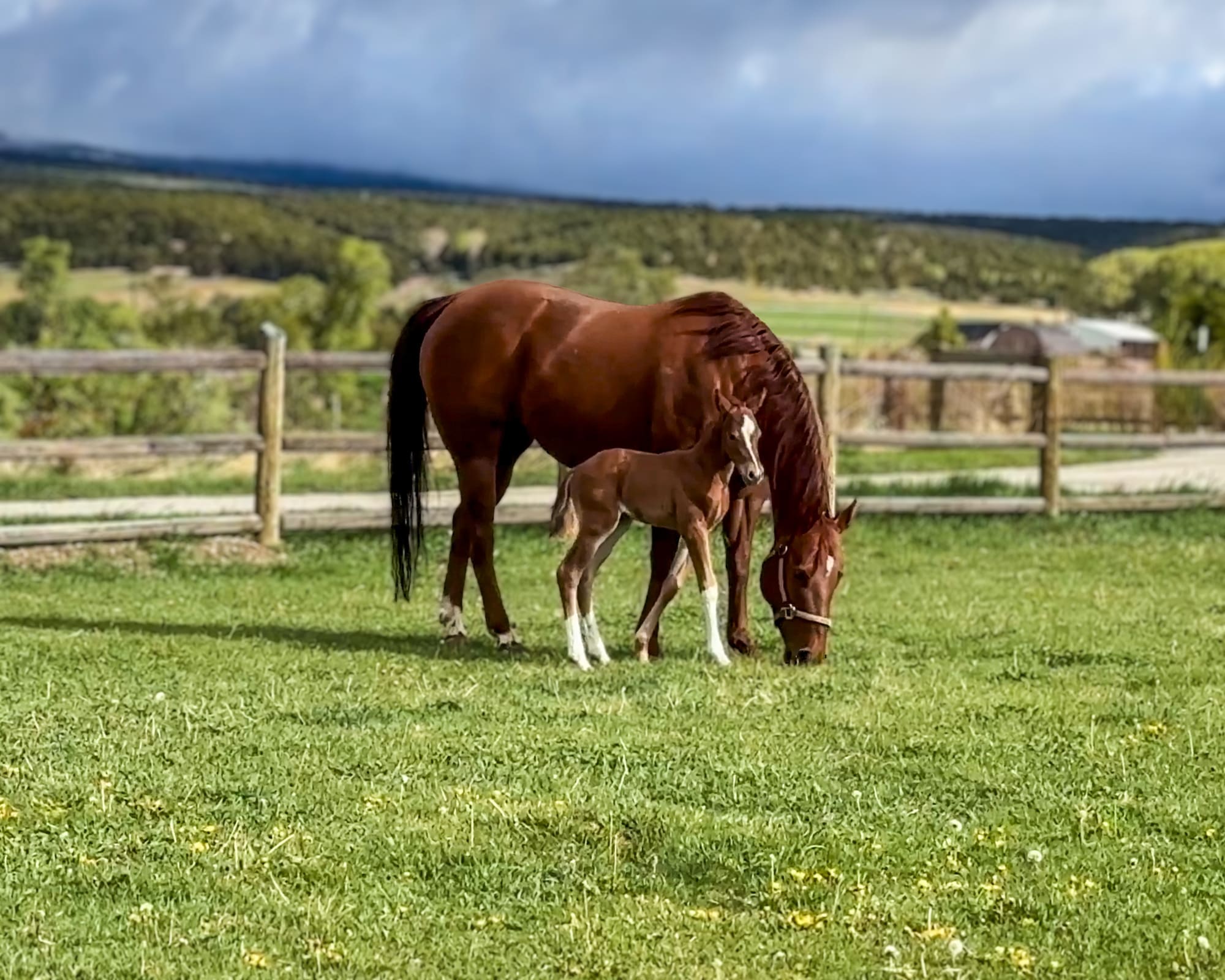
My new colt was born at the most convenient time of day, about the time most people are arriving at work. Most foals are born in the wee hours of the night. It’s Mother Nature’s way of ensuring the foal has a few hours to get up, nurse, and learn to move with mom before the sun is up and the herd is moving.
It didn’t surprise me that Annie, in her roomy and comfortable foaling stall, waited until her caretakers arrived. She’s very accustomed to her creature comforts and robust valet service. The two stayed in the foaling stall all day, with a brief trip outside in the afternoon.
Like a lot of older maiden mares, Annie was wary of the foal nursing at first, and wanted to always keep him in front of her so she could see and hold him in place with her nose. With a little support, it wasn’t long before he was gulping down the crucial first milk. Foals mostly eat and sleep the first 24 hours, so they stayed in the stall that night. The next day, the little colt was bounding around the stall and beginning to explore his world (which at the time, was the inside of that stall).
I am not a fan of “imprinting” newborns but once a colt is moving about, I like to hold him still momentarily by gently corralling him with my arms—one around his shoulders and one around his rump. This allows him to start getting accustomed to some level of restraint. Should we need to manage him (especially in an emergency), he’ll know it is not something to be scared of. It’s easy to do when they are so little, and foals learn to accept it quickly.
Later on that day, we got ready for his first real outing. While my friend “T” Cody corralled him with her arms, I slid a tiny leather foal halter on him. This is absolutely not to restrain him—I am not “halter-breaking” the foal—the purpose is only to establish an important routine in his life going forward.
It’s important to never pull on the lead rope, because a foal’s head and neck aren’t strong enough for that yet.
As we move the mare and foal from stall to turnout, one person will lead the mare, while the other pretends to lead the foal. It’s “pretend” leading because the foal is mostly following the mare around, but we slowly get him used to walking beside a human.
We gathered Annie and the foal, and ushered them up the hill to the upper paddock, where he got to see the real world for the first time. Green grass, sunshine, fences, ditches, space to run, and soft grass to land on! His world grew exponentially that day!
After a few hours of romping and napping, we repeated the haltering/leading routine and headed back to the barn. Every day since, this has been the routine, and the colt’s world has continued to grow as he explores the 3-acre field. Before long, getting that little halter out signaled that it was time for the fabulous adventure to come.
By the end of the first week, the colt was standing quietly to be haltered, walking politely beside mom and their human escort, and standing quietly for the halter to be removed in the paddock. And at the end of the second week, if he could talk, he would’ve said, “I’ve been doing it this way my WHOLE life!”
Even though his world has grown so much in these first couple of weeks, it’s still quite small. He still only knows this small place, his mom, the humans who cater to him, and the three geldings across the fence (that he cannot get close to, because Annie won’t have it).
His world, his experiences, and what he learns going forward, depends entirely on what he gets exposed to. If I want this little guy to become “worldly,” I’ll need to start gradually expanding his world as he’s ready, and give him positive life experiences.
Make Life Happen
Not all horses get exposed to this kind of handling early on in life, and many can become mature horses never having ventured off the farm, met new horses, or learned how to act in unfamiliar situations. Seasoning (giving the horse positive experiences in new settings) only happens with the diligent work of a human.
If you are working with a horse that has never been off the farm (whether he’s 3 or 15), it’s probably time to expand his horizons. Don’t plan your first excursion expecting your horse to act just like he does at home. Horses aren’t like that.
When it’s time to start growing your horse’s world and travel to new places—for a trail ride, a competition, or a clinic—you owe it to your horse to plan ahead and make sure he is confident, knows what’s expected of him, and able to perform as well as he does at home.
It’s not just going to happen overnight, you need to take steps to make it happen.

Be the Leader of Your Herd
As your horsemanship improves, so does your horse!
Understand Your Horse’s Point of View
Horses are location-specific in what they learn. In other words, they always associate a place with what they learn. Your horse can be perfectly well-trained and perform consistently every day at home, but as soon as you leave home, the horse is not sure how to act, and may need to be reminded (“Remember, this is how we do it.”).
For example, we start a young horse under saddle in a small enclosure, then advance to a bigger one, then ride outside the arena, and so on. At each new place, the horse will react differently to known cues until he realizes it’s the same here as it is there. We call it developing fluency in a cue.
At each new location that you ride the horse, its skills become more fluent, until the horse generalizes that skill to any location. This is called seasoning, or experience, and it may take years for a horse to become generalized in all its skills.
How a horse reacts to new situations is part of its temperament, but calmly accepting something new comes with training. With good handling and progressive training, the horse will become more used to accepting the unknown.
Go New Places, Routinely
 When raising and training young horses, we seek to give them as many new experiences as we can, constantly expanding their universe. We might haul a young horse to the county fairgrounds on a day when nothing is happening there, and just walk it around. The following week, maybe we’ll go back there, walk around a little, then go for a ride. Later, we’ll visit the arena when an event is happening, but just to experience it—no riding or competing.
When raising and training young horses, we seek to give them as many new experiences as we can, constantly expanding their universe. We might haul a young horse to the county fairgrounds on a day when nothing is happening there, and just walk it around. The following week, maybe we’ll go back there, walk around a little, then go for a ride. Later, we’ll visit the arena when an event is happening, but just to experience it—no riding or competing.
Horses worry about what will happen to them next. This is one reason horses thrive on routines. A familiar routine gives them the comfort of knowing what will happen to them next, and with that feeling comes calmness and confidence. It’s why we feed, turnout, and train on a regular schedule and do things in a consistent manner when we groom, pick up feet, tack up, trailer load, etc.
When you travel to a new location, their routines fall apart, giving them a feeling of uncertainty and nervousness over what will happen next. Therefore, when we travel with horses, we try to stick to what the horse knows as much as we can, from the feed, to the way we manage them, to the manners we expect them to abide by.
Horses rely heavily on context in how they respond to cues. Context is based on previous experience. If your horse knows you well, he knows when you are emotional, confident, scared, angry, etc., and he may learn to expect you to behave a certain way based on previous experiences (good or bad).
For example, if a horse has a terrible fright on its first trip to town, he may come to expect that to happen any time he leaves home. Again, consistency in the way the horse is handled and expected to behave—no matter where you are—is extremely important.

Be the Leader of Your Herd
As your horsemanship improves, so does your horse!
New Horses & New Digs
Horses are used to whatever herd situation they are raised in—big or small. Horses that are not used to being around numerous unknown horses can become quite overwhelmed, and downright fearful in the presence of numerous horses.
In the wild, strange horses may portend danger. Whether you cross paths with a group on the trail, or will encounter many new horses up-close-and-personal at a show, be aware that this could be a source of anxiety for your horse.
The same is true for the kind of accommodations your horse is used to. If the horse has never been confined in a stall and you are traveling to a place that only has stalls available, you’ll want to address that well before travel time.
How To Make It Happen
- Start Small & Focus on Confidence. Like any skill we teach the horse, we want to shape the desired behavior by taking small baby steps in the right direction. Decide what your end goal is, then break that down into about ten smaller goals. Then you will break each one of the smaller goals into steps.
- Be Sensitive to the Needs of the Individual Horse. No two horses are alike, particularly when it comes to anxiety, curiosity, sensitivity, bravery. They are all different in the amount of life experiences they’ve had and how they react to fear. We have to constantly adjust to the emotionality of the horse and do whatever is necessary to keep the horse from becoming overwhelmed, or crossing over the threshold to a full-blown emotional meltdown.
- Slow—Low—Calm. Keep everything slow and relaxed—from cueing, to your posture, to your breathing. Teach the horse to lower its head on cue and keep the horse in a calm frame with his head down. Anytime the horse tenses, take a deep breath yourself and ask it to lower its head. Hang out around other calm horses that will model appropriate behavior for your horse. At the start, ask only small easy things of the horse—things that are easy to do and that you can praise the horse for when it complies.
- Be Your Horse’s Protector (Figuratively & Literally). Whatever frightens your horse is what you need to protect it from, be it other horses, people, aloneness, strange objects. Literally act as your horse’s shield. Understand that what frightens the horse may seem silly to you, but what you think doesn’t matter. You want your horse to look to you for safety and protection.
- Be Committed to Your Horse’s Safety, Even When it’s Inconvenient. Keeping your horse’s anxiety down and building confidence in your horse means you have to go by the horse’s time frame, not your own. Don’t push your horse into something its not ready for.
- Keep a Distance from Unknown Horses & Avoid Being Around Horses That are Reactive. Stay away from places like warm-up arenas before a competition, where people are acting chaotically and no one is paying attention. Find a quiet corner where your horse can relax and observe.
- Utilize Techniques to Relieve Stress. Lowering the head, deep breathing, stroking and praising, or disengaging the hindquarters are all good ways you can help your horse. When your horse has a high level of anxiety, treat it from a mental health perspective, not as a training problem. If the horse is having a meltdown, your job is to diffuse and de-escalate the behavior first. Make sure you represent safety and calmness, and are not a cause of stress for the horse.
- Keep It Simple. Remind your horse of the cues he knows. Start with the easiest things, and lavish praise when the horse gets it right. Now is not the time to ask for anything more difficult. Getting back into a familiar training routine engages your horse’s mind and gives him a sense of normalcy, while praise for doing it right gives him a sense of well-being.
- Always Encourage Curiosity & Forward Interest. Through training, we can teach horses to convert their fear to curiosity by ruling out flight, letting the horse know it’s safe, and waiting for the moment he turns his attention forward. Click here for resources on how to do this. It’s not hard to do, and it will give the horse excellent coping skills for when it encounters the unknown.
- Don’t Be An Enabler. Don’t ignore behaviors in your horse that you wouldn’t tolerate at home, like pushing on you or shouldering-in when you lead the horse. Hopefully you established good rules of behavior and proper boundaries at home. Gently remind the horse that those rules and boundaries exist no matter where you are. This kind of structure can bring a sense of order to a chaotic world. Be the leader your horse needs.
The bottom line is, the unfamiliar is frightening to many horses. Understanding the horse’s point of view will help you manage his anxiety better. These are all reasons why—whether a horse is young or mature—it’s important to prepare your horse well, and have a plan to habituate him to the unfamiliar things he will encounter when you travel somewhere new.

